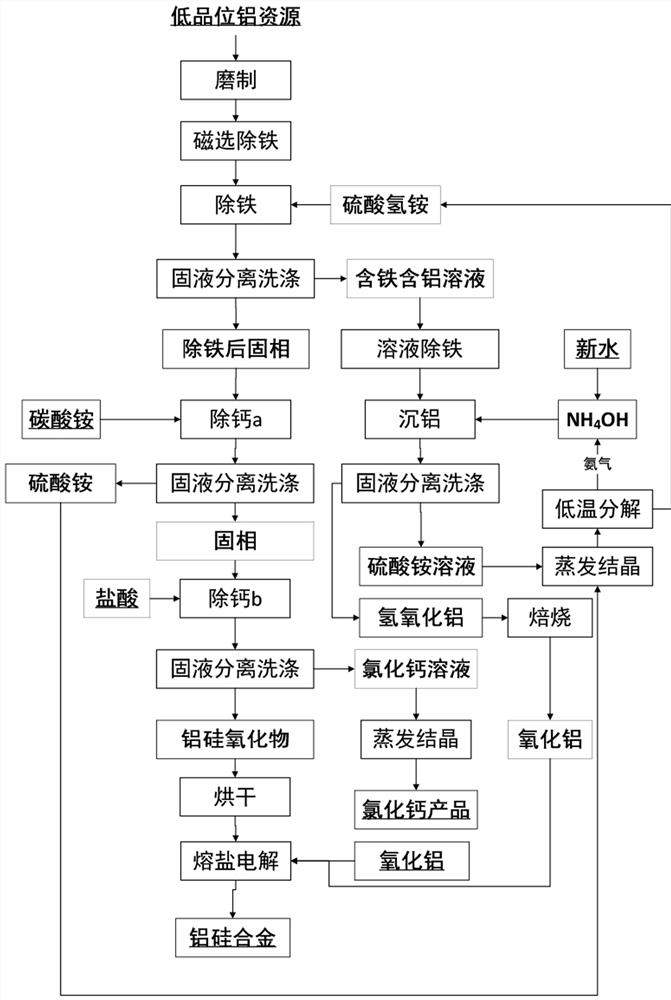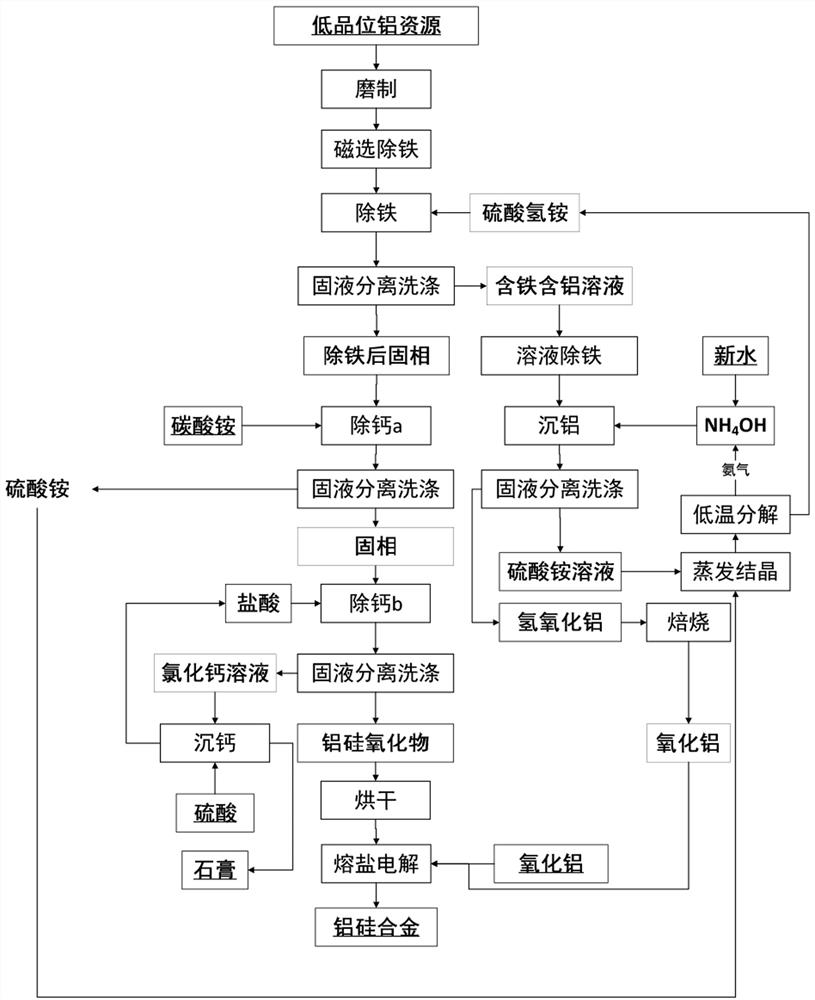A method for preparing aluminum-silicon alloys from low-grade aluminum resources
An aluminum-silicon alloy, low-grade technology, applied in the field of comprehensive utilization of resources, can solve problems affecting the quality of alloys, changes in electrolyte composition, and increased consumption of fluoride salts, and achieve the effects of perfect system, easy equipment, and low cost
- Summary
- Abstract
- Description
- Claims
- Application Information
AI Technical Summary
Problems solved by technology
Method used
Image
Examples
Embodiment 1
[0042] process by figure 1 As shown, 1000g of fly ash (chemical composition: 35% alumina, 45% silica, 4.8% iron oxide, 5% calcium oxide, 1.8% titanium oxide, 3% ignition reduction) was used for preliminary iron selection by magnetic separation. Obtain iron fine powder, which is used as raw material for ironmaking; mix the fly ash after iron selection with ammonium bisulfate solution, heat to 50°C to react, and the reaction time is 150min to heat and remove iron to reduce the iron content to 0.49%; react After solid-liquid separation and washing, a solution of aluminum ions and iron ions and solids mainly containing alumina, silicon oxide, calcium sulfate and titanium oxide are obtained; the obtained solids are washed and then added with decalcifying agent ammonium carbonate to react at 90°C 5 minutes, solid-liquid separation and washing; the obtained solid was added with hydrochloric acid to obtain a calcium chloride solution and a solid after decalcification, and carbon dioxi...
Embodiment 2
[0044] process by figure 1As shown, 1000g coal gangue (chemical composition: 28% aluminum oxide, 38% silicon oxide, 1.8% iron oxide, 6% calcium oxide, 0.8% titanium oxide, 25% reduction in ignition) was preliminarily selected for iron by magnetic separation, and obtained Iron concentrate powder is used as raw material for ironmaking; mix the coal gangue after iron selection with ammonium bisulfate solution, heat to 150°C for reaction, and heat to remove iron for 90 minutes to reduce the iron content to 0.3%; after the reaction, the solid Liquid separation and washing to obtain a solution of aluminum ions and iron ions and solids mainly containing alumina, silicon oxide, calcium sulfate and titanium oxide; the obtained solids were washed and then added with decalcifying agent ammonium bicarbonate and reacted at 100 ° C for 10 Minutes, solid-liquid separation and washing; the obtained solid is added with nitric acid to obtain a calcium nitrate solution and a solid after decalcif...
Embodiment 3
[0046] process by figure 2 As shown, 1000g of low-grade bauxite (chemical composition: 48% alumina, 27% silica, 6.2% iron oxide, 2% calcium oxide, 2.8% titanium oxide, 11% calcined reduction) was preliminarily separated by magnetic separation. iron, to obtain iron fine powder, which is used as iron-making raw material; mix the low-grade bauxite after iron selection with ammonium bisulfate solution, heat to 280°C for reaction, and the reaction time is 5 minutes to heat and remove iron, so that the iron content is reduced to 0.2%; solid-liquid separation and washing after the reaction to obtain a solution of aluminum ions and iron ions and a solid containing aluminum oxide, silicon oxide, calcium sulfate and titanium oxide; React at 20°C for 90 minutes, solid-liquid separation and washing; add nitric acid to the obtained solid to obtain a calcium nitrate solution and a solid after decalcification, and generate carbon dioxide gas for solid-liquid separation and washing; the obta...
PUM
 Login to View More
Login to View More Abstract
Description
Claims
Application Information
 Login to View More
Login to View More - R&D
- Intellectual Property
- Life Sciences
- Materials
- Tech Scout
- Unparalleled Data Quality
- Higher Quality Content
- 60% Fewer Hallucinations
Browse by: Latest US Patents, China's latest patents, Technical Efficacy Thesaurus, Application Domain, Technology Topic, Popular Technical Reports.
© 2025 PatSnap. All rights reserved.Legal|Privacy policy|Modern Slavery Act Transparency Statement|Sitemap|About US| Contact US: help@patsnap.com


